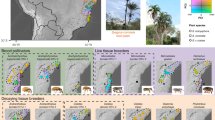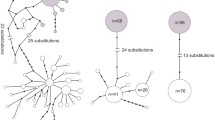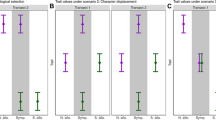Abstract
Ecological speciation occurs when inherent reproductive barriers to gene flow evolve between populations as a result of divergent natural selection. Frequency dependent effects associated with intraspecific resource competition are thought to be one important source of divergent selection facilitating ecological speciation. Interspecific competition may also play an important role in promoting population divergence. Although evidence for interspecific competition in nature is ubiquitous, there is currently little empirical data supporting its role in the speciation process. Here, we discuss two general models in which interspecific competition among species can promote ecological speciation among populations within a species. In both models, interspecific competition is the source of divergent selection driving adaption to different portions of the resource distribution, generating ecological reproductive isolation from other conspecific populations. We propose that the biology of endoparasitoids that attack phytophagous insects make model systems for studying the role of interspecific competition in ecological speciation. We describe details for one such system, the community of endoparasitic braconid wasps attacking Rhagoletis fruit flies, as a potential model for investigating competitive speciation. We conclude by hypothesizing that a model in which interspecific competition forces an inferior competitor to alternative fly hosts may be a common theme contributing to parasitoid diversification in the Rhagoletis-parasitoid system.


Similar content being viewed by others
References
Ackermann, M., & Doebeli, M. (2004). Evolution of niche width and adaptive diversification. Evolution, 58, 2599–2612.
Armstrong, R. A., & McGhee, R. (1980). Competitive exclusion. American Naturalist, 115, 151–170.
Bengtsson, J. (1989). Interspecific competition increases local extinction rate in a metapopulation system. Nature, 340, 713–715.
Berlocher, S. H., McPheron, B. A., Feder, J. L., & Bush, G. L. (1993). Genetic differentiation at allozyme loci in the Rhagoletis pomonella (Diptera, Tephritidae) species complex. Annals of the Entomological Society of America, 86, 716–727.
Bolnick, D. I. (2001). Intraspecific competition favours niche width expansion in Drosophila melanogaster. Nature, 410, 463–466.
Bolnick, D. I. (2004). Can intraspecific competition drive disruptive selection? An experimental test in natural populations of sticklebacks. Evolution, 58, 608–618.
Bolnick, D. I., & Lau, O. L. (2008). Predictable patterns of disruptive selection in stickleback in postglacial lakes. American Naturalist, 172, 1–11.
Bolnick, D. I., & Preisser, E. L. (2005). Resource competition modifies the strength of trait-mediated predator-prey interactions. Ecology, 86, 2771–2779.
Brigatti, E., Sa Martins, J. S., & Roditi, I. (2006). Evolution of biodiversity and sympatric speciation through competition in a unimodal distribution of resources. Physica A, 376, 378–386.
Burger, R., Schneider, K. A., & Willensdorfer, M. (2006). The conditions for speciation through intraspecific competition. Evolution, 60, 2185–2206.
Bush, G. L. (1966). The taxonomy, cytology, and evolution of the genus Rhagoletis in North America (Diptera, Tephritidae). Bulletin of the Museum of Comparative Zoology, 134, 431–562.
Coyne, J. A., & Orr, H. A. (2004). Speciation. Sunderland, MA: Sinauer Associates.
Darwin, C. (1859). The origin of species by means of natural selection (1st ed.). London: Murray.
Denno, R. F., McClure, M. S., & Ott, J. R. (1995). Interspecific interactions in phytophagous insects: competition reexamined and resurrected. Annual Review of Entomology, 40, 297–331.
Dieckmann, U., & Doebeli, M. (1999). On the origin of species by sympatric speciation. Nature, 400, 354–357.
Diehl, S. R., & Bush, G. L. (1989). The role of habitat preference in adaptation and speciation. In D. Otte & J. Endler (Eds.), Speciation and its consequences (pp. 345–365). Sunderland, MA: Sinauer Associates.
Doebeli, M. (1996). A quantitative genetic competition model for sympatric speciation. Journal of Evolutionary Biology, 9, 893–909.
Doebeli, M., & Dieckmann, U. (2000). Evolutionary branching and sympatric speciation caused by different types of ecological interactions. American Naturalist, 156, S77–S101.
Doebeli, M., & Dieckmann, U. (2003). Speciation along environmental gradients. Nature, 421, 259–264.
Drossel, B., & McKane, A. (2000). Competitive speciation in quantitative genetic models. Journal of Theoretical Biology, 204, 467–478.
Egan, S. P., & Funk, D. J. (2009). Ecologically dependent postmating isolation between sympatric ‘host forms’ of Neochlamisus bebbianae leaf beetles. Proceedings of the National academy of Sciences of the United States of America, 106, 19426–19431.
Egan, S. P., Janson, E. M., Brown, C. G., & Funk, D. J. (2011). Postmating isolation and genetically variable host use in ecologically divergent host forms of Neochlamisus bebbianae leaf beetles. Journal of Evolutionary Biology, 24, 2217–2229.
Feder, J. L. (1995). The effects of parasitoids on sympatric host races of Rhagoletis pomonella (Diptera: Tephritidae). Ecology, 76, 801–813.
Feder, J. L., Chilcote, C. A., & Bush, G. L. (1988). Genetic differentiation between sympatric host races of the apple maggot fly Rhagoletis pomonella. Nature, 336, 61–64.
Feder, J. L., Hunt, T. A., & Bush, L. (1993). The effects of climate, host-plant phenology and host fidelity on the genetics of apple and hawthorn infesting races of Rhagoletis pomonella. Entomologia Experimentalis et Applicata, 69, 117–135.
Feder, J. L., Opp, S. B., Wlazlo, B., Reynolds, K., Go, W., & Spisak, S. (1994). Host fidelity is an effective premating barrier between sympatric races of the apple maggot fly. Proceedings of the National academy of Sciences of the United States of America, 91, 7990–7994.
Forbes, A. A., Fisher, J., & Feder, J. L. (2005). Habitat avoidance: Overlooking an important aspect of host-specific mating and sympatric speciation? Evolution, 59, 1552–1559.
Forbes, A. A., Powell, T. H. Q., Stelinski, L. L., Smith, J. J., & Feder, J. L. (2009). Sequential sympatric speciation across trophic levels. Science, 323, 776–779.
Forbes, A. A., Hood, G. R., & Feder, J. L. (2010). Geographic and ecological overlap of parasitoid wasps associated with the Rhagoletis pomonella (Diptera: Tephritidae) species complex. Annals of the Entomological Society of America, 103, 908–915.
Funk, D. J., Filchak, K. E., & Feder, J. L. (2002). Herbivorous insects: Model systems for the comparative study of speciation ecology. Genetica, 116, 251–267.
Funk, D. J., Nosil, P., & Etges, W. J. (2006). Ecological divergence exhibits consistently positive associations with reproductive isolation across disparate taxa. Proceedings of the National academy of Sciences of the United States of America, 103, 3209–3213.
Gavrilets, S. (2004). Fitness landscapes and the origin of species. In Monographs in population biology (Vol. 41). Princeton, NJ: Princeton University Press.
Godfray, H. C. J. (1994). Parasitoids: Behavioral and evolutionary ecology. Princeton, NJ: Princeton University Press.
Goldberg, D. E., & Barton, A. M. (1992). Patterns and consequences of interspecific competition in natural communities: A review of field experiments with plants. American Naturalist, 139, 771–801.
Gray, S. M., & Robinson, B. W. (2002). Experimental evidence that competition between stickleback species favours adaptive character divergence. Ecology Letters, 5, 264–272.
Gurevitch, J., Morrow, L. L., Wallace, A., & Walsh, J. S. (1992). A meta-analysis of competition in field experiments. American Naturalist, 14, 539–572.
Harvey, J. A., Corley, L. S., & Strand, M. R. (2000). Competition induces adaptive shifts in caste rations of a polyembryonic wasp. Nature, 406, 183–186.
Harvey, J. A., & Partridge, L. (1987). Murderous mandibles and black holes in hymenopteran wasps. Nature, 326, 128–129.
Hawkins, B. A., & Lawton, J. H. (1987). Species richness for parasitoids of British phytophagous insects. Nature, 326, 788–790.
Johnson, P. A., & Gullberg, U. (1998). Theory and models of sympatric speciation. In D. J. Howard & S. H. Berlocher (Eds.), Endless forms: Species and speciation (pp. 79–89). New York, NY: Oxford University Press.
Kaneko, K. (2002). Symbiotic sympatric speciation: Consequences of interaction-driven phenotype differentiation through developmental plasticity. Population Ecology, 44, 71–85.
Kaplan, I., & Denno, R. F. (2007). Interspecific interactions in phytophagous insects revisited: A quantitative assessment of competition theory. Ecology Letters, 11, 841–851.
Kondrashov, A. S., & Kondrashov, F. A. (1999). Interactions among quantitative traits in the course of sympatric speciation. Nature, 400, 351–354.
La Salle, J., & Gauld, I. D. (1991). Parasitic Hymenoptera and the biodiversity crisis. Redia, 74, 315–334.
Lathrop, F. H., & Newton, R. C. (1933). The biology of Opius melleus Gahan, a parasite of the blueberry maggot. Journal of Agricultural Research, 48, 143–160.
Linn, C., Feder, J. L., Nojima, S., Dambroski, H. R., Berlocher, S. H., & Roelofs, W. (2003). Fruit odor discrimination and sympatric host race formation in Rhagoletis. Proceedings of the National academy of Sciences of the United States of America, 100, 11490–11493.
Lowry, D. B., Modliszewski, J. L., Wright, K. M., Wu, C. A., & Willis, J. H. (2008). The strength and genetic basis of reproductive isolating barriers in flowering plants. Philosophical Transactions of the Royal Society B, 363, 3009–3021.
Maestre, F. T., Valladares, F., & Reynolds, J. F. (2005). Is the change of plant–plant interactions with abiotic stress predictable? A meta-analysis of field results in arid environments. Journal of Ecology, 93, 748–757.
Nosil, P., Funk, D. J., & Ortíz-Barrientos, D. (2009). Divergent selection and heterogeneous genomic divergence. Molecular Ecology, 18, 375–402.
Nosil, P., Vines, T. H., & Funk, D. J. (2005). Perspective: reproductive isolation caused by natural selection against immigrants from divergent habitats. Evolution, 59, 705–719.
Ovruski, S., Aluja, M., Sivinski, J., & Wharton, R. (2000). Hymenopteran parasitoids on fruit-infesting Tephritidae (Diptera) in Latin American and the Southern United States: Diversity, distribution, taxanomic status and their use in fruit fly biological control. Integrated Pest Management Reviews, 5, 81–107.
Pennings, P. S., Kopp, M., Meszena, G., Dieckmann, U., & Hermisson, J. (2008). An analytically tractable model for competitive speciation. American Naturalist, 171, E44–E71.
Pfennig, K. S., & Pfennig, D. W. (2005). Character displacement as the “best of a bad situation”: Fitness trade-offs resulting from selection to minimize resource and mate competition. Evolution, 59, 2200–2208.
Pfennig, D. W., & Rice, A. M. (2007). An experimental test of character displacement’s role in promoting postmating isolation between conspecific populations in contrasting competitive environments. Evolution, 61, 2433–2443.
Pfennig, K. S., & Pfennig, D. W. (2009). Character displacement: Ecological and reproductive responses to a common evolutionary problem. The Quarterly Review of Biology, 84, 253–276.
Prichard, J. R., & Schluter, D. (2001). Declining interspecific competition during character displacement: Summoning the ghost of competition past. Evolutionary Ecology Research, 3, 209–220.
Rainey, P. B., & Travisano, M. (1998). Adaptive radiation in a heterogeneous environment. Nature, 394, 69–72.
Rice, A. M., & Pfennig, D. W. (2010). Does character displacement initiate speciation? Evidence of reduced gene flow between populations experiencing divergent selection. Journal of Evolutionary Biology, 23, 854–865.
Rosenzweig, M. L. (1978). Competitive speciation. Biological Journal of the Linnean Society, 10, 275–289.
Roughgarden, J. (1972). Evolution of niche width. American Naturalist, 106, 683–718.
Rundle, H. D., & Nosil, P. (2005). Ecological speciation. Ecology Letters, 8, 336–352.
Schluter, D. (2000a). The Ecology of Adaptive Radiation. Oxford: Oxford University Press.
Schluter, D. (2000b). Ecological character displacement in adaptive radiation. American Naturalist, 156, S4–S16.
Schluter, D. (2001). Ecology and the origin of species. Trends in Ecology & Evolution, 16, 372–380.
Schluter, D. (2003). Frequency dependent natural selection during character displacement in sticklebacks. Evolution, 57, 1142–1150.
Seger, J. (1985). Intraspecific resource competition as a cause of sympatric speciation. In P. J. Greenwood, P. H. Harvey, & M. Slatkin (Eds.), Evolution: Essays in honour of John Maynard Smith. Cambridge: Cambridge University Press.
Slatkin, M. (1980). Ecological character displacement. Ecology, 61, 163–177.
Taper, M., & Case, T. J. (1992). Coevolution among competitors. Evolutionary Biology, 8, 63–109.
van Nouhuys, S., & Punju, E. (2009). Coexistence of competiting parasitoids: Which is the fugitive and where does it hide? Oikos, 119, 61–70.
Acknowledgments
GRH would like to thank P. Morton for continuous support and SPE would like to thank J. L. Greene for permanent support. JLF and GRH would like to thank Mazatlan in Pendleton, OR. Funding was provided by NSF and USDA grants awarded to JLF and The Entomological Society of America, Sigma Xi and The Indiana Academy of Science grants awarded to GRH.
Author information
Authors and Affiliations
Corresponding author
Rights and permissions
About this article
Cite this article
Hood, G.R., Egan, S.P. & Feder, J.L. Interspecific Competition and Speciation in Endoparasitoids. Evol Biol 39, 219–230 (2012). https://doi.org/10.1007/s11692-012-9182-7
Received:
Accepted:
Published:
Issue Date:
DOI: https://doi.org/10.1007/s11692-012-9182-7




